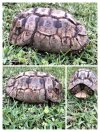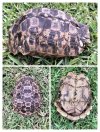AmeliaCharles
New Member
Hi all!
I am new to the forum and hoping someone could identify these 2 tortoises we spotted walking across the lawn at a game lodge in KZN. I thought Leopard but the hinge behind is throwing me off and now I am not sure what these chaps/ladies species are, maybe one of the hinged species ? Any help would be greatly appreciated, trying to learn as much as possible.
I am new to the forum and hoping someone could identify these 2 tortoises we spotted walking across the lawn at a game lodge in KZN. I thought Leopard but the hinge behind is throwing me off and now I am not sure what these chaps/ladies species are, maybe one of the hinged species ? Any help would be greatly appreciated, trying to learn as much as possible.

